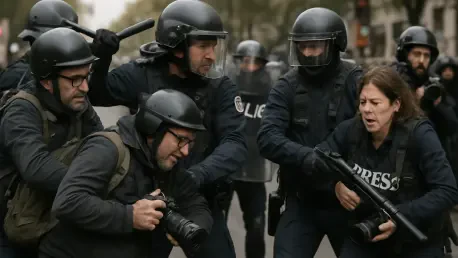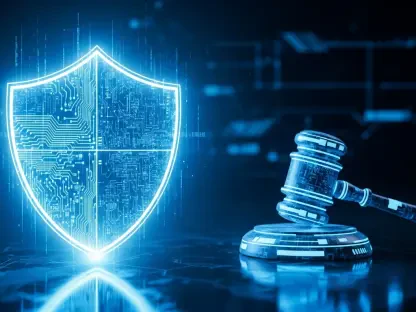In the heart of France, a disturbing trend has emerged during the recent “Block Everything” (Bloquons tout) protests, where journalists tasked with documenting public dissent have faced alarming levels of aggression from law enforcement, challenging the very principles of press freedom. On September 10, these nationwide demonstrations, which drew between 197,000 and 250,000 participants, became a battleground not just for protesters but for media personnel striving to uphold the public’s right to information. Reports from cities like Paris, Montpellier, Pau, and Toulouse paint a grim picture of press freedom under siege, with police actions directly contradicting national guidelines designed to protect journalists. The National Law Enforcement Plan (SNMO) of 2021 explicitly safeguards reporters’ ability to cover events, even during undeclared or banned protests. Yet, the reality on the ground tells a different story, raising urgent questions about the state of democratic principles in France and the safety of those who inform the public.
Escalating Aggression Against Journalists
The scale of violence directed at journalists during the “Block Everything” protests is both shocking and deeply concerning, with at least seven documented cases of abuse by police forces. In Montpellier, freelance journalist Samuel Clauzier, working for Rue89Bordeaux, endured two harrowing incidents: first, being sprayed with tear gas at close range, rendering him incapacitated for ten minutes, and later, suffering physical assault and camera damage while filming an arrest. Meanwhile, in Pau, Emmanuel Hoarau of L’Humanité faced repeated shoves from officers during tense moments of crowd control. These incidents are not mere isolated mishaps but part of a broader pattern of intimidation. The physical toll on journalists, who were clearly identifiable by helmets and armbands marked “press,” underscores a blatant disregard for their protected status under national law, casting doubt on the effectiveness of existing safeguards meant to ensure their safety while reporting on public events.
Further illustrating the widespread nature of this issue, journalists in Toulouse and Paris also encountered severe aggression from law enforcement during the same protests. Photographer Morgan Bisson of Hans Lucas photo agency in Toulouse sustained injuries to her hand and equipment after being struck by a baton while capturing an arrest on camera. In Paris, the situation was equally dire, with Lisa Lap of Le Média receiving a punch to her helmet, and her colleague Lisa Noyal suffering an eye injury from a deliberate poke. Additionally, Jose Rexach of Blast was wounded by stun grenade shrapnel, and independent reporter Enzo Rabouy was hit on the wrist by a baton during a police charge. These repeated acts of hostility across multiple cities reveal a systemic challenge, where the fundamental right to report on public matters is jeopardized by the very forces tasked with maintaining order. The personal and professional risks faced by these media workers highlight an urgent need for accountability and reform in police conduct.
Systemic Failures and Legal Contradictions
Beyond individual accounts, the violence against journalists points to a deeper systemic failure within France’s approach to press freedom during social movements. Despite the protections outlined in the National Law Enforcement Plan (SNMO), the reality on the ground suggests a significant gap between policy and practice. Reporters Without Borders (RSF), through Director General Thibaut Bruttin, has condemned these acts as clear abuses that undermine the essential role of journalists in informing society. RSF has meticulously documented the incidents from the September protests and has called on affected reporters to seek support for appropriate action. The organization also notes a troubling resurgence of police hostility toward media personnel, a trend observed during earlier demonstrations this year and worsened by recent updates to the National Law Enforcement Plan (SNVU) on September 4. These updates, criticized by RSF, appear to roll back previous advancements in journalist protection, signaling a regression in safeguarding press rights.
Adding to the complexity, the recurring nature of these incidents indicates that the issue is not merely a momentary lapse but a persistent challenge to democratic values in France. The right to information, a cornerstone of any free society, is directly threatened when journalists face punches, baton strikes, and tear gas simply for doing their jobs. RSF’s ongoing warnings highlight a pattern of aggression during social protests, suggesting that without stronger enforcement of protective measures, the situation may continue to deteriorate. The tension between law enforcement practices and the principles of press freedom remains unresolved, with recent policy changes only exacerbating the problem. This persistent hostility not only endangers individual reporters but also erodes public trust in the mechanisms meant to uphold transparency and accountability during times of unrest, leaving a critical void in the democratic process that relies on an informed citizenry.
Pathways to Protecting Press Freedom
Reflecting on the events of September 10, it became evident that the violent encounters between police and journalists during the “Block Everything” protests had exposed a critical fracture in the framework meant to protect media rights. Moving forward, actionable steps must be prioritized to address this breach, starting with a thorough reevaluation of police training and protocols to ensure alignment with national guidelines like the SNMO. Authorities should consider independent oversight mechanisms to investigate and address complaints of violence against the press, fostering greater accountability. Additionally, dialogue between law enforcement and media organizations could help bridge misunderstandings and reinforce the importance of journalists’ roles during public demonstrations. These measures, if implemented, could pave the way for safer reporting environments in future protests.
Moreover, the role of advocacy groups like RSF proved invaluable in documenting past abuses and pushing for systemic change, and their efforts should be supported by policymakers and the public alike. Strengthening legal protections through updated legislation that explicitly penalizes attacks on journalists could serve as a deterrent to future aggression. Public awareness campaigns might also play a part in highlighting the importance of press freedom, encouraging societal pressure on authorities to uphold these rights. As France navigates ongoing social tensions, ensuring that reporters can work without fear of retribution remains a vital step toward preserving democratic integrity. The path ahead demands collaboration and commitment to restore trust and safety for those tasked with keeping the public informed during critical moments of dissent.









